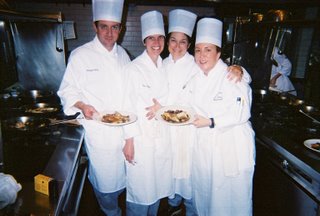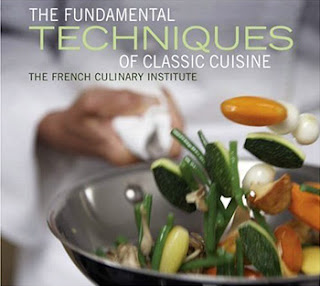Techniques teaches the 250 classic foundation techniques including stocks, sauces, soups, salads, eggs, potatoes, poultry, game, beef, veal, lamb, pork, fish, shellfish, marinades, stuffings, organ meats (my least favorite day in cooking school!), pastry dough, creams & custards, crepes, brioche, frozen desserts, meringues, mousses, and soufflés (my favorite day in cooking school! 🙂 As I flipped the pages, 6 months of my life flashed before my eyes, intermittently cringing while remembering slicing off the tip of my thumb on the mandoline or burning my wrist on the convection oven and laughing out loud picturing the over-whipped genoise, splattered pommes anna, and over-salted Poulet Rôti Grand-mère.
Many if not all of the recipes in my humble little blog, such as a Christmas Menu and Magret de Canard aux Figues de Vendée, are based on the foundation and techniques I learned in cooking school. Techniques also explains in great detail terms in a kitchen, names of equipment and pots and pans (and the difference between stainless steel and aluminum, cast iron, non-stick and the benefits and pit falls of each), food safety, knifes and knife skills, and professional kitchen management.
If you want to become an great home chef or are considering or about to attend cooking school, I implore you to devour (pun intended) this book. If you learn all the techniques, or at least become familiar with them, then you will be leaps and bounds ahead of the game. Bon courage et bon appetit!

Michael, Beverly, Michele, and me proudly displaying our Poulet Rôti Grand-mère
Poulet Rôti Grand-mère -- Grandmother's Roast Chicken
Serves 4
Estimated time: 1-1/2 hours
Ingredients
For the chicken:
• 3-1/2 lb (1.5 kg) roasting chicken (including neck, gizzards, heart)
• coarse salt, fresh ground pepper
• 2 tablespoons (30 gr) unsalted butter
• 2 tablespoons (30 ml) vegetable oil
• 3-1/2 ounces (100 gr) carrots, mirepoix (rough chopped)
• 3-1/2 ounces (100 gr) onions, mirepoix (rough chopped)
For the garnish:
• 14 ounces (400 gr) russet potatoes, peeled
• 3-1/2 ounces (100 gr) slab bacon
• 4-1/2 ounces (125 gr) button mushrooms, cleaned
• coarse salt, fresh ground pepper
• 2-1/2 ounces (70 gr) pearl onions
• 3 tablespoons (40 gr) unsalted butter
• 1 teaspoon (7 gr) sugar
• 2 tablespoons (30 ml) vegetable oil
• 2 tablespoons (10 gr) flat leaf parsley, finely chopped
For the gravy:
• 3-1/2 tablespoons (50 ml) dry white wine
• 2 cups + 2 tablespoons (500 ml) brown veal stock
• coarse salt, fresh ground pepper to taste (optional)
Equipment:
• Chef's Knife
• Trussing twine
• Trussing needle (optional)
• Heavy-bottomed roasting pan or poêle
• Instant read thermometer (if necessary)
• Paring knife
• Large shallow saucepan
• Strainer
• Small, sharp knife
• Sauté pan
• Slotted spoon
• Paper towels
• Stainless steel bowl
• Sautoir or russe
• Parchment paper
• Ovenproof poêle
• Heatproof bowl
• Wire rack
• Baking pan
• Wooden spoon
• Boning knife
• Large metal spoon
• 4 warm dinner plates (I will never ever ever forget Chef Henri admonishing us with "Hot food, hot plate. Cold food, cold plate!")
Preparation
1. Prepare your mise en place.
2. Preheat the oven to 450°F (232°C)
3. Remove and reserve the gizzard, neck and heart from the chicken; set the liver aside for another use. Using a chef's knife, carefully trim the chicken of excess fat. Season and truss the chicken.
4. Heat the butter and oil in a heavy-bottomed roasting pan or poêle over medium heat. Add the chicken and sear, turning frequently without pricking the skin, for about 10 minutes or until the thighs and legs are well-browned and the breast is just lightly browned.
5. When all sides have browned, turn the chicken on its back and add the gizzard, neck and heart to the pan. Place the pan in the oven and roast for 10 minutes.
6. Add the mirepoix vegetables and toss to coat with a bit of fat.
7. Continue to roast, basting frequently, for about 40 minutes or until the skin is golden brown and the juices run clear from a hole poked in the thigh or when the internal temperature measured between the breast and thigh registers 60°C to 66°C (140°F to 150°F).
8. While the chicken is roasting, prepare the garnish.
9. Using a paring knife, turn the potatoes into 5-centimeter (2-inch) cocottes (small football shapes with 7 sides). Place the potatoes in a single layer in a large shallow sauce pan with cold water to just barely cover over high heat. Bring to a simmer. Immediately remove from heat, drain well without refreshing, and set aside to air dry.
10. Cut the bacon into 1/2-inch (1.3-centimeter) thick slices and then into strips about 1/2-inch (1.3-centimeter) wide to form lardons.
11. Place the bacon in a sauté pan over medium-high heat and sauté for about 5 minutes or until the bacon has rendered its; fat but has not browned. sing a slotted spoon, transfer the lardons to paper towels to drain, leaving the rendered fat in the sauté pan.
12. If the mushrooms are small, leave them whole; if large, cut them into quarters. Add the mushrooms to the rendered bacon fat. Place the pan over medium heat, season the mushrooms with salt and pepper to taste, and sauté for about 5 minutes or until just lightly browned on the edges. Set aside.
13. Place the onions in a stainless steel bowl with hot water to cover. Soak for about 3 minutes or until the skins have loosened. Drain well and, using your fingertips, push off the skins.
14. Place onions in a single layer in a sautoir or russe just large enough to accommodate them over medium heat. Add 1 tablespoon (15 gr) of the butter, the sugar, and just enough water to barely cover the bottom of the pan. Salt to taste. Cover with a piece of parchment cut to the exact size of the pan opening to make a loose lid and glacer à brun (cook until a golden brown). (Take care not to use too much water, as the onions will steam and overcook rather than brown. They should begin to brown in the remaining butter after the water has evaporated.) Taste, and if necessary, add seasoning. Set aside and keep warm until ready to serve.
15. About 10 minutes before the chicken is ready to come out of the oven, heat an ovenproof poêle over medium heat. When hot but not smoking, add the oil. Add the potatoes, keeping them in a single layer. Sauté for about 5 minutes or until all of the potatoes are evenly browned. Add the remaining 2 tablespoons (25 gr) of butter and season with salt and pepper to taste. Please the potatoes in the oven and roast for 10 to 12 minutes or until golden brown and tender when pierced with the point of a small, sharp knife.
16. When all the garnish items have been cooked, combine them in a heatproof bowl. Toss to blend, then sprinkle with parsley. Set aside and keep warm for service.
17. When the chicken is done, remove it from the oven, drain off and reserve the fat, and transfer the bird to a wire rack placed over a baking pan to rest. While the chicken is resting, make the gravy (jus de rôti)
18. If the pan drippings have not caramelized during roasting, place the pan on the stovetop over high heat and bring to a boil. Boil just until the drippings caramelize; take care that they do not burn. Carefully drain off the fat. Lower the heat and add the white wine to the pan, stirring constantly with a wooden spoon to lift up the sucs and deglaze the pan. Add the stock and stir to combine. Bring to a boil, then lower the heat and cook at a bare simmer, stirring frequently, for about 10 minutes or until the mixture is slightly reduced and fall-flavored. Taste, and if necessary, season with salt and pepper. Strain. Keep warm until ready for service.
19. Using a boning knife, remove the breasts and the thighs from the chicken. Manchonner the ends of the drumsticks (cut off the big joint at the end of the drumstick) and the wings. Cut each breast half into two pieces on the bias. Cut the legs in half at the joint. Remove the thigh bones and any cartilage. You should now have 8 pieces
20. Assemble one leg piece with one breast piece on each of the four warm dinner plates, taking care that only one of the pieces on each plate has a bone.
21. Garnish each plate with an equal portion of the warm vegetables. Spoon the gravy around the chicken pieces. Serve remaining gravy on the side.
WHEW! All that for a roast chicken!
Bon appetit!

